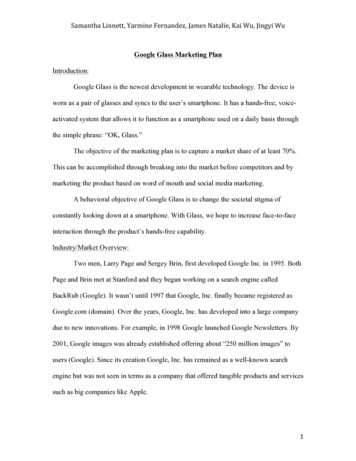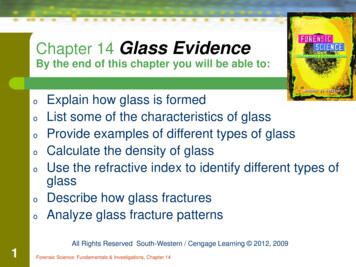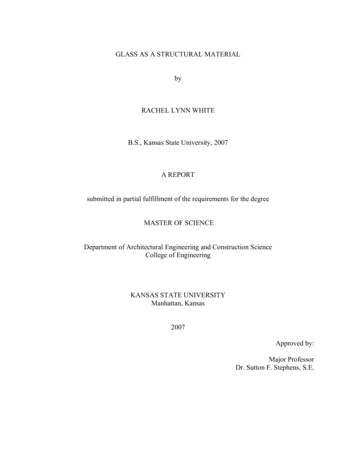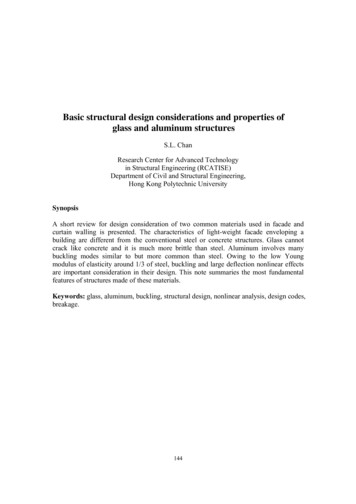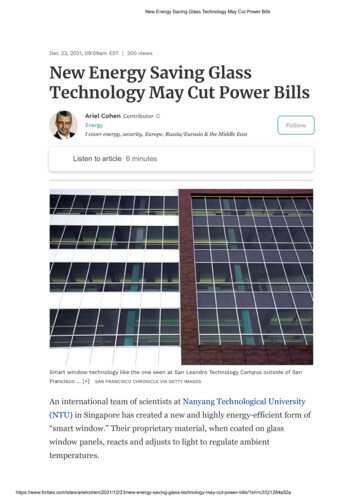
Transcription
New Energy Saving Glass Technology May Cut Power BillsDec 23, 2021, 09:09am EST 200 viewsNew Energy Saving GlassTechnology May Cut Power BillsAriel Cohen ContributorEnergyFollowI cover energy, security, Europe, Russia/Eurasia & the Middle EastListen to article 6 minutesSmart window technology like the one seen at San Leandro Technology Campus outside of SanFrancisco . [ ]SAN FRANCISCO CHRONICLE VIA GETTY IMAGESAn international team of scientists at Nanyang Technological University(NTU) in Singapore has created a new and highly energy-efficient form of“smart window.” Their proprietary material, when coated on glasswindow panels, reacts and adjusts to light to regulate ology-may-cut-power-bills/?sh c3321284a52a
New Energy Saving Glass Technology May Cut Power BillsThis novel technology can switch between heating and cooling dependingon incoming light wavelengths, thereby slashing energy usage and costused to control indoor climate. With politicians and scientists urgingemission cuts of 45 % globally by 2030, breakthroughs like this areparamount in our effort to cut energy consumption.Existing technology simply cannot meet growing energy demands, sobreakthroughs like this one at NTU will play a pivotal role in achievingglobal energy reduction goals.Total U.S. Greenhouse Gas Emissions by Economic Sector in 2019EPAMost windows today are highly inefficient. Energy losses from windows –and the energy required to compensate – led to almost one gigaton r-bills/?sh c3321284a52a2/6
New Energy Saving Glass Technology May Cut Power BillsCO2 emissions annually, approximately the same as the aviation industry.According to the US Department of Energy, 25% to 30% of the energyused to heat and cool homes results from heat loss or gain from windows.MORE FOR YOUfiflCOP26 Re ections: The Speci cs & The SignalsHashiCorp Shares Rise In Latest Open-Source IPO, Minting NewBillionaireIs Net-Zero Manufacturing Within Reach?Windows lose and absorb heat as glass responds to external weather.When the sun glares into a window on a hot day, the glass allows a highpercentage of this energy in. Once inside, the properties of glass make itdifficult for this energy to escape (greenhouse effect). In extreme cold,glass is also ineffective at trapping heat without costly insulation andmultiple panes.The smart glass developed at NTU can simultaneously handle differenttemperatures, responding to incoming light waves in a way that maintainstemperature equilibrium. In hot weather, it suppresses solar heatingwhile boosting radiative cooling, a natural phenomenon where heat emitsthrough surfaces towards colder temperatures. When outsidetemperatures cool, it does the opposite to heat the spaces inside.Laboratory evidence showed the new glass could react to changes inweather conditions. In the summer and winter months, the glass showedenergy-saving performance of up to 9.5%.Forbes t-power-bills/?sh c3321284a52a3/6
New Energy Saving Glass Technology May Cut Power BillsREAD MOREfiThis technology could have an enormous effect on energy ef ciency in urban centers. (Photo by .[ ]GETTY IMAGESSpeaking on the project’s success, principal investigator Dr. Long Yi said,“while innovations focusing on radiative cooling have been used on wallsand roofs, this function becomes undesirable during winter. Our team hasdemonstrated for the first time a glass that can respond favorably to bothwavelengths, meaning that it can continuously self-tune to react to achanging temperature across all seasons."Conventional cooling measures often involve using optical film to reflectsunlight, which becomes detrimental in colder temperatures wherenatural light is required to create warmth.Similar technologies that alleviate energy costs have been made moreregularly available in the last decade. Both trombe and solar shingledwalls use natural sunlight to passively heat buildings through ut-power-bills/?sh c3321284a52a4/6
New Energy Saving Glass Technology May Cut Power Billsabsorption. However, they require electronic components that must beinspected often to ensure efficiency. This differs completely from the glasscoating developed by NTU, which has no complicated internal wiringsystems.In addition to solar-powered and heat-saving glass technologies,researchers at the University of North Texas invented biodegradableinsulation that has shown promise in slightly increasing heating andcooling capabilities. The compostable material showed a 12% increase intemperature control efficiency. Despite its biodegradability, theenvironmentally friendly foam has been predicted to be as long-lasting asconventional insulation.Another ambitious invention challenged experts to consider using sunrays to power electronic equipment near motorways. In 2016, Frenchtransport infrastructure company Colas patented solar paved highways,using traditional cells to generate clean energy under heavy vehicles.Acting as autonomous power generators, the panels on the road wereintended to power any type of energy-consuming equipment near thehighway. However, despite the apparent potential, the project ultimatelyfailed to account for cloud-cover in areas with little sunlight and cost over 5.5 million, prompting Colas to cease its operation.Accounting for economic and weather-related efficiency promptsimportant conversations regarding the future of renewable constructiontechnologies. While in the last decade, the average residential cost of solarpower fell by 62%, installation remains relatively costly. Considering theexpenses required to construct walls, roofs, and insulation made out ofenvironmentally friendly and solar-operated materials, the invention ofNTU’s temperature efficient glass-coating shows significant progress inproviding both energy and cost-efficient alternatives for buildingconstruction.Skyrocketing energy prices this winter demonstrate that cost cannot beignored when discussing green energy. High renewable energy prices willslow the transition away from fossil power-bills/?sh c3321284a52a5/6
New Energy Saving Glass Technology May Cut Power BillsThe rising energy costs have already prompted dirty gas-to-coal switchingacross Europe amidst power shortages, in part due to the intermittency ofrenewable generation and insufficient smart grid and storage. Onesignificant way to lower electric bills is to use less energy in the first party– this is the heart of the efficiency strategy.In the era of rapidly increasing investment in renewable energyinfrastructure, such as those considered by the Biden administration,experts and policymakers should ponder the introduction of privatelyfunded initiatives that alter conventional building technologies.Innovations like those developed by NTU underscore the importance offostering technological progress, including the promotion of energyefficiency.With assistance from Liam TaylorFollow me on Twitter or LinkedIn. Check out my website or some of myother work here.Ariel CohenFollowI am a Senior Fellow at the Atlantic Council and the Founding Principal ofInternational Market Analysis, a Washington, D.C.-based global risk advisory boutique.fiI advise law rms and corporations, and once helped to get a famous Russianoligarch out of Putin’s jail. I am also a Senior Fellow with the International Tax andInvestment Center (ITIC) where I direct their Energy, Growth, and Security Program(EGS). For 22 years, I was the Heritage Foundation’s leading Russia/Eurasia andinternational energy expert. My consultancy focuses on political risk, nationalsecurity, and energy policy, especially in Russia/Europe/Eurasia, and the Middle East.fiThe rm’s interventions span international security, economics, law, politics,terrorism, and crime and corruption. In addition to consulting for both the publicand private sectors, I testify regularly before the U.S. Congress, and appear onBloomberg, CNN, FOX, BBC, Al Jazeera, and other TV channels. In my free time, Ienjoy skiing, sailing, classical music, and my two cats. Read wer-bills/?sh c3321284a52a6/6
Billionaire Is Net-Zero Manufacturing Within Reach? Windows lose and absorb heat as glass responds to external weather. When the sun glares into a window on a hot day, the glass allows a high percentage of this energy in. Once inside, the properties of glass make it difficult for this energy to escape (greenhouse effect). In extreme cold,




